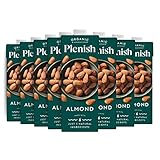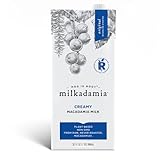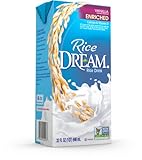
We are probably quite familiar with probiotic micro-organisms and milk products which contain them like yoghurts. Have you ever thought that vegetable and nut milks might be good vehicles for probiotics?
Nut milks have great market and commercial potential and are now to be seen on the supermarket shelf. Take almond and hazelnut to name a couple which are seen as healthy as dairy milks. Also, one other major reason for nut or vegetable milk consumption is the prevalence of dairy related allergies and intolerance. They also appear to be beneficial for diabetics because of their lower glycaemic index (Lovejoy, 2005).

The nut milks, especially almond and hazelnut are good sources of dietary fats and oils, carbohydrates, and some dietary fibre (Bradley et al., 2011).
Hazelnut in particular has a superb lipid profile which is mainly oleic acid coupled with vitamin E- a potent nutritional antioxidant. It has a strong sensory appeal and is valued in mainly confectionary products (Tey et al., 2011a). This nut has been assessed in studies which demonstrate its cholesterol lowering effects (Tey et al., 2011b)
Product development of non-dairy milks is relatively straightforward. They are great matrices for added inulin and other prebiotics, so a fibre claim is perfectly feasible. They can sustain probiotics too by providing a fermentation medium which in turn is helped by prebiotic addition to increase viscosity and improve processability leading to better shelf-life and sustained sensory qualities (De Souza-Oliviera et al., 2009).
Barista Blends
Barista blends are not the same as the standard nut milks. They are designed for foaming, frothing and steaming. These are used for latte, frothy coffees and espressos. They work well too in iced coffees but their real benefit comes from use in hot beverages where most nut milks would simply breakdown. The reason they work is they contain a multiple gum system along with a few minerals that stabilise the foam. The most effective gum system is one of gellan gum with another such as locust bean gum.
Competition with Dairy Milks
Whilst the aisles are full of many different nut and other plant-based milks, there is still plenty of competition with dairy. Dairy milk is still largely holding its own against the non-dairy variants. The International Dairy Foods Association claimed from their 2019 survey that 86% of all adults still prefer dairy milk. Admittedly it is a survey conducted by a pro-dairy organization but it reveals to some extent that non-dairy plant milks have not taken over yet!
One feature that ways heavily against the non-dairy alternatives is the cost. The average retail price of conventional whole milk in 2022 for example is $4.33 per gallon whilst the cheapest non-dairy alternative is considerably higher. There also seems to be a significant absence of nut ingredients for example in a nut milk. It is difficult to convince a consumer that an almond milk might only contain 2% almonds as with Blue Diamond. One of the issues both with the ingredient list and the cost is that nuts for example are still extremely expensive to grow and there is still variability in harvesting from one year to another. In the non-dairy plant alternative’s favour is that cost is allied to quality and whilst it is costly it also offers additional nutrients not found in milk alone.
One of the issues that prevents some consumers choosing dairy is their lactose-tolerance. Plant milks simply don’t have lactose so it’s never an issue.
Whilst dairy is attacked for its environmental credentials the nut milks are not in a much better position. Most nut trees need water and in some parts of the globe that is becoming a scarcer commodity. Almond trees are heavily water dependent and appear to be drying up California. About 82% of the world’s supply of almonds comes from California. It takes about 12 litres of water per kernel which seems enormous in resource usage (Fulton et al., 2017). They grow well in Spain and other parts of Southern Europe but require much more water than many other trees. There is a similar issue with the avocado tree which is even more moisture acquisative.
Commercial Viability of Nut Milks
Oat milks have soared in value this year where 5 years ago they hardly existed. This represents a threat to nut milks generally because strong health messages can be ascribed to oats rather than nuts.
From 2014 onwards, almond milk was 60% of the plant milk sales and 4.1% of total milk sales in the USA alone. Almond milk remained static in growth in 2021 and into 2022. There was a small drop in sales but it is the clear category leader in the US retail sector with sales of $1.277bn whilst oat milk is next at $527.44m which is a significant gap.
The current key sub-segments 52 weeks to June 12th, 2022 sourced from SPINS for the USA are:
#2 oat milk +50.22% to $527.44m (excludes blends)
#3 soy milk: -0.09% to $165.09m
#4 coconut milk: -8.16% to $82.1m
Blends involving almond with either coconut or cashew have dropped away to $60.55m and $17.05m respectively. It shows that apart from almond none of the pther nuts are making much headway in this space. It’s likely they are just too expensive to process and there is a shortage in supply.
In the UK we spent £146 million on oat milks in 2020 and £105 million on almond milk.
Key Companies
The main players in nut milks are the following:
- Blue Diamond Growers
- Pacific Foods of Oregon, LLC
- MALK Organics
- Mariani Nut Company
- Daiya Foods, Inc.
- McCormick and Co.
- Goya Foods, Inc.
- Galaxy Nutritional Foods Inc.
- Whitewave Food
- Elmhurst Milked Direct LLC
The main almond milk brands are Almond breeze, Elmhurst 1925, Mooala, Silk ad Kirkland Signature.
Blue Diamond have a world famous product called Almond Breeze Long Life Unsweetened which is a UHT product with added calcium and vitamins. Blue Diamond largely rely on Californian grown almonds. The energy content per 100ml is 53 kJ with a fat content of 1.1g. The almond content of the product is only 2% and relies on gellan gum as the stabiliser.
Barista blends have been developed with professionals in mind and rely on a four-gum stabiliser system – carrageenan, locust bean gum, sodium alginate, guar gum.
If you like a strong organic message then MALK organics might be for you. Their products are certified organic and glyphosate-free. The weedkiller-free claim has resonance with those who abhor the use of this product to treat weeds but it is not a truly strong claim.
One of the most expensive almond milk is from Rude Health which is also perceived by some to be too thin because it lacks gums for creating a better mouthfeel than others..
Plenish (London, UK) offer everything from soya to almond, cashew, hazelnut and coconut as well as oat milks. They claim to make all their products from just 3 natural ingredients. They are building extensively on their claims such as being certified carbon negative, being sustainably sourced also using no gums.
One of the largest US independents is Califia farms who offer the same sort of ranges that others manage. They have a very well regarded Barista Blend too which has been created so that a full-bodied foam can be formed. Whilst some businesses still have soya, there is a move away from soy generally because of environmental issues. Being soy-free is now a major claim.
Macadamia nut is a polarising flavour for some it makes a great nut milk. Milkadamia (Oakbrook terrace, Illinois, USA) produce unsweetened and latte-ready barista variants in cartons as well as original which is lightly sweetened but not suited to barista-style coffee. The lightly sweetened version contains just 6g of sugar which is claimed to be half the sugar of 1% dairy milk but it is costly at $21.48 for 32 fl. oz. (Amazon, 2022).
As well as vanilla flavours there is Veggnog Macadamia and a White Chocolate peppermint Macadamia version. Veggnog is Christmas addition.
In the UK, Nutty Bruce also have an organic almond milk which is 5% almond with some added organic brown rice and sea salt but no added sugar. No gums are used which means there is a thinner mouthfeel. They also do variants with coconut milk, or oat milk.
Some of the main retailers in the UK have launched their own brands. They seem to compare favourably in taste tests. Sainsbury’s and Aldi have their versions of almond milk which are rated highly. Look for Wicked Kitchen from Tesco who offer four milks including oat milk, almond, coconut and soya in the much-vaunted barista blend style. These are in 1 litre cartons that sit on the ambient shelf. In 2022, they were retailing at £1.30 to £1.50 (The Grocer, 2022). Barista blends should froth and are used in frothy coffees. They are also fortified with vitamins B, B12 and D.
If you like soymilk, then try Silk who produce unsweetened organic soymilks.
The soymilk is infused with a vitamin and mineral blend of calcium carbonate, vitamin A, vitamin D2, riboflavin B2 and vitamin B12. Again, a UHT product which should compete successfully in the plant milk sector. It is generally cheaper than nut counterparts and currently retails at $15.79 ($0.08/ Fl. Oz.) according to Amazon.
Rice milks are available from the brand Dream Blends (SunOpta Grains and Foods Inc.) are flavoured with vanilla because it is an extremely bland tasting product. It is marginally more expensive than soy at $0.11/Fl. Oz. The product also plays heavily on the health and environmental credentials.
Comparisons Of Nut Milks With Oat Milks
Oat milks compare favourably with nut milks. The leading contender is almond milk. Both are excellent alternatives to dairy milk but they do have an unfortunate lack in mouthfeel and taste until you become accustomed to their texture and flavour.
Oat milk has a higher protein content than almond milk but it also has a higher carbohydrate value. There has been renewed interest in reduced sugar variants of oat milk to redress the issue and also improve the sweetness of oat milk. the high starch content of oat milk means there is a slightly more powdery feel to the texture. Almond milk is thinner than regular cow’s milk with a distinct almond flavour.
Almond milk is probably better for anyone looking for a reduced carbohydrate diet. An 8 oz. serving of unsweetened almond milk contains 37 kcal, 1 gram of carbohydrates, no sugar but 3 grams of fat, 1 gram of protein and 480 mg of calcium. When it is sweetened with say brown rice syrup say, the sweetened version has a calorie content of 93 kcal, 16 grams of carbohydrates, 15 grams of sugar, 3 grams of fat, 1 gram of protein and 459 mgs of calcium.
By comparison, as oat milk has a higher protein content, a typical oat milk contains 120 kcal of energy, 16 grams of carbohydrates, 7 grams of sugar, 5 grams of fat, 3 grams of protein and 350 grams of calcium.
Oat milks are ideal for anyone with a nut allergy but cross-contamination with gluten is an issue for anyone who is intolerant or coeliac. It has higher calcium, potassium and phosphorous contents than almond milk. Its also sweeter because of the sugars especially those oat milks where starch has been hydrolysed. The protein and fiber contents are higher which gives it a satiety and possible heart health claim. Almond milk is better for anyone needing a lower protein alternative.
References
Bradley, W., Bolling, C.Y., Chen, O., McKay, D.L. & Blumberg, J.B. (2011). Tree nut phytochemicals: composition, antioxidant capacity, bioactivity, impact factors. A systematic review of almonds, Brazils, cashews, hazelnuts, macadamias, pecans, pine nuts, pistachios and walnuts. Nutr. Res. Rev., 24, pp. 244–275.
De Souza-Oliviera, R.P., Perego, P., Converti, A. & de Oiliveira, M.N. (2009). The effect of inulin as prebiotic on the production of probiotic fibre-enriched fermented milk. Int. J. Dairy Technology, 62 pp. 195–203.
Fulton, J., Norton, M. Shilling, F. (2018) Water-indexed benefits and impacts of California almonds. Ecological Indicators. https://doi.org/10.1016/j.ecolind.2017.12.063 .
Lovejoy, J.C. (2005). The impact of nuts on diabetes and diabetes risk. Curr. Diabetes Reports, 5 pp. 379–384.
Tey, S.L., Brown, R., Chisholm, A., Gray, A., Williams, S. & Delahunty, C. (2011a). Current guidelines for nut consumption are achievable and sustainable: a hazelnut intervention. Brit. J. Nutr., 105, pp. 1503–1511.
Tey, S.L., Brown, R.C., Chisholm, A.W., Delahunty, C.M., Gray, A.R. & Williams, S.M. (2011b). Effects of different forms of hazelnuts on blood lipids and α-tocopherol concentrations in mildly hypercholesterolemic individuals. Eur. J. Clin. Nutr. 65 pp. 117–124.






Get your visa waiver sorted if u want to buy these milks. The best seller is Alpro and given we are coming out of Europe soon I think we are going to be finding these a lot dearer because the US will put the price up. Almond milk is all I have. haven’t drank cows milk for about three years. this is all i use; for oat/cereal, smoothies, sometimes cooking and just to drink on it’s own when i feel like.